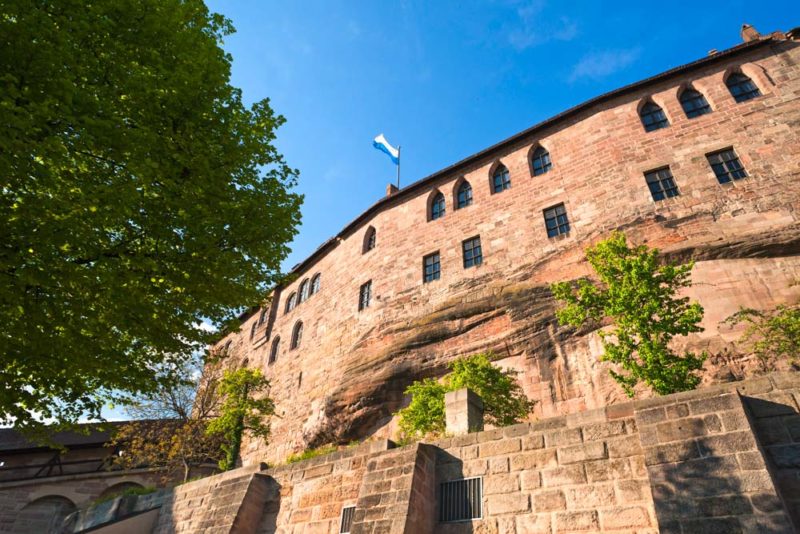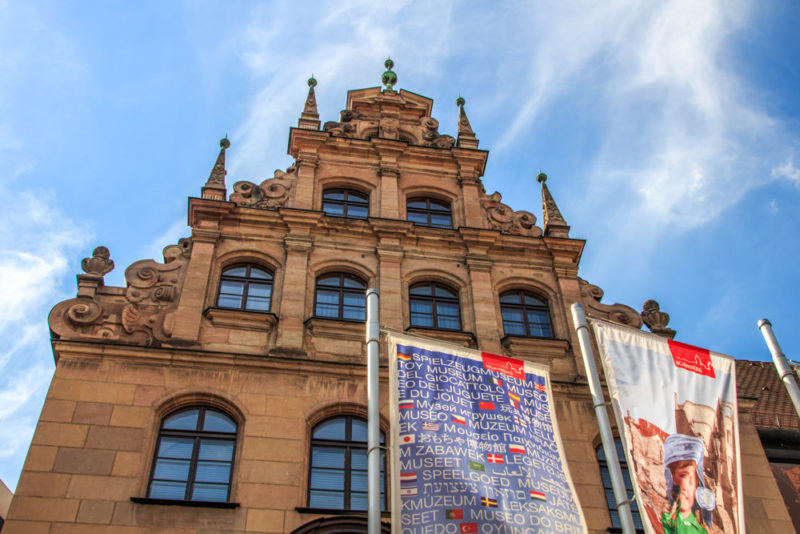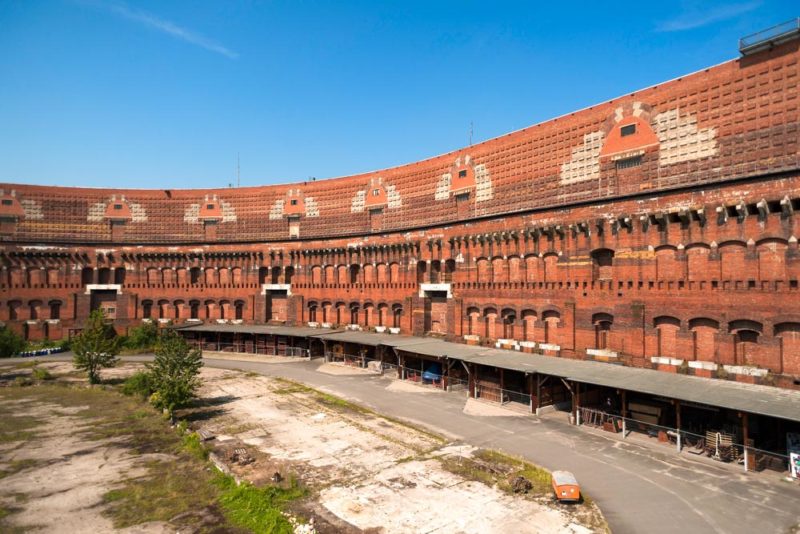Visit Bavaria, and you have to include Nuremberg, the state’s second-largest city, on your travel itinerary. This is a destination that’s full of romance, history, folklore, fairy tales, and good German beer. Plus, you’ll love exploring the medieval streets and charming museums of this beautiful city!
Nuremberg is located along the banks of the River Pegnitz, and the city has a long history that stretches back at least a thousand years, if not beyond. You’ll quickly spot Nuremberg’s imposing Imperial Castle looming over the Altstadt (Old Town). And as you stroll through cobblestone streets, admiring the colorful timber-framed buildings and traditional architecture, you’ll learn that this was one of the most important cities in the medieval Holy Roman Empire.
As with many German cities, much of Nuremberg’s Altstadt was destroyed during World War II. The Old Town was lovingly restored, and you can learn more about the city’s role during the conflict by visiting the Documentation Center Nazi Party Rally Grounds museum and the courthouse where the Nuremberg Trials were held.
You’ll learn how the city has dealt with its past mistakes, but you’ll also see firsthand how Nuremberg has preserved the lighter elements of German culture and its own unique regional culture. While Nuremberg is part of Bavaria, it’s also part of another sub-region called Franconia. The Franconian dialect is still strong, local folklore tales and legends are still popular, and Franconian beer, wine, and cuisine are still absolutely delicious!
With so many wonderful things to see and do, you might not know where to begin. That’s why we’ve compiled our list of the absolute best things to do in Nuremberg for you. Stick to these fun and unique Nuremberg bucket list recommendations, and there’s no doubt that you’re going to have an incredible time exploring this beautiful German city!
Don’t forget to check out our web story: The 15 Best Things to do in Nuremberg, Germany
Disclaimer: This post may contain affiliate links. If you make a purchase or booking through one of our links we may earn a small commission (don’t worry, it’s at no extra cost to you).
15 Fun and Unique Things to do in Nuremberg
1. Explore Nuremberg’s historic Altstadt (Old Town)

If it’s your first time in the city and you’re wondering what to do in Nuremberg, the best place to start your trip is in the Altstadt (Old Town). Nuremberg’s Altstadt is one of the best and most colorful examples of a medieval town in Germany, although as with many historic locations throughout the country, much of what you see today had to be painstakingly restored after the destruction of World War II.
Don’t let the restoration take away from the fact that Nuremberg’s Altstadt is beautiful and incredibly historic. This is the heart of the city – both old and new – and you can start exploring from the famous Hauptmarkt on the northern side of the Pegnitz River.


The Altstadt is surrounded by the remains of Nuremberg’s city walls, and the medieval streets extend from both sides of the river, with the two areas connected by spectacular bridges, including the 16th century Fleischbrucke. In the Hauptmarkt, you’ll find Nuremberg’s Town Hall as well as the charming Schoner Brunnen, a 14th-century fountain built with Gothic designs.
Walk north of the Hauptmarkt, stroll through medieval streets, and you’ll soon reach the Imperial Castle of Nuremberg. This massive structure marks the northern extent of the Altstadt, and for centuries, it was the focus not just of the city, but it played an important role in the wider Holy Roman Empire that stretched across much of Europe throughout the Middle Ages.
On the south side of the river, you’ll find just as much impressive architecture, including the famous St. Lorenze church. There are museums throughout the Altstadt, including the Albrecht Durer House, the Toy Museum, the City Museum, and the Deutsches Museum.
2. Learn about the Holy Roman Empire at the Imperial Castle

The Imperial Castle of Nuremberg, or the Kaiserburg, is one of the most important Nuremberg sightseeing attractions. The impressive castle still dominates the Altstadt to this day, with a history dating back to at least the 10th century AD when the first fortifications were built on the hilltop here.
The castle was extended on numerous occasions, and the tall stone walls and towers stand high above the surrounding timber-framed buildings of the Altstadt. The Imperial Castle of Nuremberg came to symbolize the power and authority of the Holy Roman Empire, which ruled much of Europe from the medieval era until the 19th century.


You can visit much of the castle during your stay in Nuremberg, including the Castle Museum, which is located within the Palas and Chapel. This was the focal point of the castle, and the palace is where the Holy Roman Emperors lived, worked, and prayed during their visits to Nuremberg.
The castle’s most famous landmark is Sinwell Tower, which you’ll see in many photographs of Nuremberg! Constructed in the 13th century, you can make the steep climb to the top of the staircase for spectacular panoramas over the castle and Nuremberg.
3. Walk Nuremberg’s extensive City Walls

A walk along the extensive City Walls is one of the best things to do in Nuremberg. During the Middle Ages, most large towns and all cities across Europe would be built inside city walls. However, as cities have expanded, many of these unique bastions, towers, and tall stone fortifications have been torn down, destroyed, or simply lost to time.
That’s not the case in Nuremberg, where you have the opportunity to explore one of Europe’s best examples of medieval city walls during your stay. Nuremberg’s City Walls date back to the 12th century AD, and of the original three miles that were built, well over two miles remain standing. There are upwards of 70 towers, too, alongside several medieval gateways and gatehouses that are still in use.


Where the walls have been torn down or destroyed over time, there are often convenient markers demonstrating where they once stood. You can easily trace the extent of the walls around the Old Town (on both sides of the river), a lovely historical walk that’s packed full of medieval surprises!
4. Release your inner child at the Toy Museum

Adults and kids alike will love the refreshing fun of the Toy Museum, which we like to think is one of the best things to do in Nuremberg. You’ll find the Toy Museum located within a historic 16th-century building in the Altstadt, and inside, you’ll find thousands of toys, the oldest of which date back centuries!
Nuremberg has always had a toy-making tradition, and the museum is based on the vast collection of historic (and modern) toys started by Lydia and Paul Bayer, Bavarian locals who amassed an impressive 12,000 toys from around the world.


The museum opened to the public in 1971, and since then it has grown to hold over 80,000 toys. Although, there’s space for just a fraction of this number to be on permanent display.
Those displays showcase the history of toys and toy making, and you can see everything from traditional, hand-painted toy soldiers and figurines to Lego and model railway exhibitions.
5. Delve into Germanic culture at the Germanisches Nationalmuseum

This is a city that’s packed with different museums, but one of the best Nuremberg attractions to visit is the excellent Germanisches Nationalmuseum (or the German National Museum). Located on the southern side of the River Pegnitz, this historic institution dates back to 1852 and focuses on the history and culture of German-speaking peoples across Europe.
The museum has a broad scope in this respect, and you’ll find that the permanent and temporary exhibitions cover almost the entire history of Germanic culture, from its early beginnings right to the present. That means there’s a lot for you to see, with over 1 million objects in the collection and tens of thousands of those objects on display at any one time.


The collection is impressive, and you’ll find early stone age tools, medieval weapons and religious relics, and even a self-portrait by Rembrandt. The exhibits cover prehistory, the Middle Ages, the early modern era, and the contemporary. You’ll quickly find that hours have passed while you browse through history and culture!
Interestingly, you’ll find that the new and old buildings of the museum are intersected by the Way of Human Rights. This unique monument contains 30 tall pillars, each of which is inscribed with a passage from the Declaration of Human Rights. The monument is one way in which the city approaches its darker, Nazi-era past and shows just how far Nuremberg has come since World War II.
6. Visit the Documentation Center Nazi Party Rally Grounds

Nuremberg has a darker 20th-century history. You may already know that the city played a prominent role in the rise of the Nazis and was the scene of the infamous Nuremberg Trials in the aftermath of World War II.
Rather than sweeping this all under the rug, though, Nuremberg has tackled its recent past head-on. During the 1930s, Nuremberg hosted infamous Nazi rallies at the purpose-built Congress Hall. This extravagant coliseum-style parade ground has now been turned into a Documentation Center and a place of education called the Documentation Center Nazi Party Rally Grounds.


The permanent exhibition at the museum is titled Fascination and Terror, and offers an eye-opening journey through the history of the Nazi Party. The exhibition demonstrates how the Nazi Party was allowed to come to power, and ultimately, shows how anything similar can be halted in the future.
7. Explore the aftermath of WWII at the Nuremberg Courthouse

Although it may not always be visible among the medieval Old Town, Nuremberg is still inseparable from its World War II history. As well as being infamous for its association with the rise of the Nazi Party to power, Nuremberg is perhaps even more associated with the trials of the Nazi leadership at the end of the conflict.
Due to this association and involvement with the Nazi Party, the Allies chose Nuremberg as the place where the surviving Nazis would face justice for their actions during the war. The historic events took place in the Palace of Justice outside the Altstadt. Often called “the greatest trial in history,” the Nuremberg Trials revealed Nazi atrocities to the world.


As with the Documentation Center Nazi Party Rally Grounds, the courthouse has been preserved as an educational tool for future generations. In fact, the actual courthouse where the trials took place remained a working court of law until 2020.
It’s quite eerie, but you can see the courtroom where some of history’s greatest villains were sentenced. Above the courtroom, you’ll find the museum, where you can learn more about the Nuremberg Trials and the Nazis who were put on trial.
8. Learn all about Nuremberg’s favorite artist

One of Germany’s most famous artists is Albrecht Durer, a Renaissance painter, printer, sculptor, and engraver who was born and raised in Nuremberg. Durer’s House, which he lived in from 1509 until 1528, is now one of Nuremberg’s most popular museums. You’ll find it right in the middle of the Altstadt, just a short stroll away from the Imperial Castle.
Durer was prolific during his career, and he dabbled in many forms of artistry and was on par – if less well known – with the Italian Renaissance greats. Durer’s home was turned into a museum dedicated to his life and work in 1871 (on the anniversary of his birth), and it’s a fascinating place for art lovers to explore. You’ll find artwork and paintings, as well as Renaissance-era furnishings and decor that show what it was like to live and work in Nuremberg in the 1500s.


The house itself is one of the best-preserved medieval homes in the Altstadt. The distinctive timbered facade is brightly painted, and the original building dates back to 1420, although much of it had to be restored following World War II.
9. Admire modern art at the Neues Museum

Are you an art lover? Then you’re going to love the modern art on display at the Neues Museum. This museum is one of the coolest things to do in Nuremberg, and you’ll find the sleek contemporary design and glass facade of the building stands in stark contrast to the surrounding Old Town architecture.
Head inside the Neues Museum, and you’ll find a unique selection of exhibitions showcasing the works of both local and international artists in the modern era. Exhibitions blur the lines between art and design.


Plus, there’s incredible photography and light work, and there’s a wonderfully refreshing (and modern) selection of work that makes a progressive change from the medieval art you’ll have seen throughout the Altstadt.
There’s an ever-changing cycle of temporary exhibitions at the Neues Museum, so check the calendar to see what’s planned during your Nuremberg sightseeing trip. Most intriguing of all, you’ll be surprised to learn that the rooftop of the Neues Museum is home to a large colony of bees. The endangered bees are not only being saved, but the city’s beekeepers harvest the honey, which you can then purchase in the gift shop!
10. Eat, drink, & shop at Handwerkerhof Nuremberg

If you’re in the market for quirky souvenirs to take home, then you’ll find all you need at Handwerkerhof, where you can eat, drink, and shop in a medieval-themed marketplace!
Handwerkerhof is located on the southern side of the Altstadt, within a historic section of the city walls that was once the royal armory. Step through the medieval gateway, and you’ll find yourself transported back in time. Yes, it’s quite touristy, but we love it anyway.


Handwerkerhof is home to a wonderful selection of craft stalls and shops, and you’ll find lots of opportunities to purchase handmade goods as you browse through the market. There are also lots of opportunities to sample and buy local delicacies, including Nuremberg’s famous sausages.
11. Go underground (and drink beer) in the Rock-Cut Cellars

One of the coolest things to do in Nuremberg is an underground tour of the city’s Rock-Cut Cellars. For hundreds of years, tunnels, cellars, and storehouses were carved below the city, and you can now take a tour to learn more about this subterranean world!
While many of the underground vaults were simply used as prisons, many more were used to store beer or even as beer brew houses. During World War II, many of these Rock-Cut Cellars were used as air-raid shelters, while today, some are also still in use for storage and now tourism.


One local brewer offers tours below ground of the extensive network of cellars – which measure some 20,000 square meters in total – and ends the experience with beer drinking at their Nuremberg tavern!
12. Try the famous Nuremberg sausages

At this point in your trip, we expect you’re starting to get hungry. Luckily, Nuremberg has plenty of tasty dishes for you to try! The city is highly regarded for its local Franconian cuisine, which to an outsider seems very heavy on meat and sauerkraut.
If you are a meat-eater, then you’ll want to try the famous Nuremberg sausages, which can only be produced in this region of Bavaria. In fact, you’ll be surprised to learn that there are strict rules governing what counts as a Nuremberg sausage, such is the seriousness with which Nurembergers take their sausages. A Nuremberg sausage is around 3 inches long, and it’s thinner and smaller than standard German bratwurst, although similar in taste.


Nuremberg sausages are best enjoyed with a local beer. If you’re a vegetarian, we recommend sticking to the local potato or asparagus salads. However, you may get lucky and stumble across a veggie version of the Nuremberg sausage on occasion!
13. Revel in Nuremberg’s Christmas festivities

Christmas is a glorious time of year to visit Nuremberg, and we know you’re going to love the seasonal festivities, markets, and Christmas cheer that swipe through the city!
The highlight, of course, is the Christmas Market – or the Christkindlesmarkt, as the locals call it. Nuremberg’s extravagant Christmas Market is one of the best and oldest in the world, and you’ll find it suitably located in the Hauptmarkt, right in the heart of the Altstadt.


It’s a historic location for a historic Christmas market, and you’ll appreciate the quaint wood huts and timber stalls that add to the sense of timeless tradition. If you’re on the hunt for Christmas presents, you’ll find an abundance of gifts to choose from, including handmade arts and crafts, Christmas decorations, and traditional Bavarian clothing, among much more.
The Christmas Market is also well known for its culinary offerings, and you can indulge in warming mulled wine, gingerbread, and Nuremberg’s world-famous sausages.
Nuremberg’s Christmas Market begins at the end of November, and it kicks off with a traditional schedule of festive events, including carol singing and the introduction of the Christkind. The market continues until December 24, giving you plenty of time to enjoy the festivities!
14. Go hiking in Nuremberger Land
The countryside to the east of Nuremberg is beautiful, and it’s the perfect place to enjoy a day of hiking. Known as Nuremberger Land, you’ll quickly find yourself a long way from city life as you hike through valleys, take in sweeping panoramas from hilltops, and stumble across historic castles and romantic rural villages.
Grab a map in Nuremberg, and start planning because there are over 1,000 miles worth of waymarked trails that you can follow in the region. Many are accessible via public transport from the city, making for an excellent opportunity for a rural day trip.
You can find inspiration for your hikes on the Nuremberger Land website. Plus, you’ll be able to tailor routes to suit your experience, fitness level, and sightseeing goals.
15. Road trip the Romantic Road

Do you love road tripping? Then we’ve got the perfect route for you to drive: The Romantic Road!
This 285-mile driving route takes you through Bavaria’s most beautiful, dreamy, and romantic destinations, and it starts (or ends) in Wurzburg, a historic town that’s just to the northwest of Nuremberg.
From Wurzburg, the route heads south and continues all the way down to the border with Austria. You don’t have to drive the whole thing, of course, and if you choose to tackle the northern sections, you’ll never be more than a 1- to 2-hour drive away from Nuremberg.


Highlights of the Romantic Road include Wurzburg, Rothenburg ob der Tauber, Augsburg, and the fairy tale Neuschwanstein Castle. The route is aptly named because it passes through many of Bavaria’s most “romantic” towns and villages, where you’ll find beautiful medieval architecture, rural charms, and enduring Germanic traditions to explore.
You can enjoy day trips from Nuremberg to the nearest destinations on the Romantic Road using the city as your home base for a multi-day itinerary, or you could hit the road for a week-long road trip once you’ve seen all of the best things to do in Nuremberg!
There you have it! The 15 best things to do in Nuremberg. What’s your favorite thing to do in Nuremberg?
Planning a trip to Germany? Check out our favorite books and travel guides!
SHARE THIS ON PINTEREST



Frequently Asked Questions
If it’s your first time in the city and you’re wondering what to do in Nuremberg, the best place to start your trip is in the Altstadt (Old Town). Nuremberg’s Altstadt is one of the best and most colorful examples of a medieval town in Germany, although as with many historic locations throughout the country, much of what you see today had to be painstakingly restored after the destruction of World War II.
The Imperial Castle of Nuremberg, or the Kaiserburg, is one of the most important Nuremberg sightseeing attractions. The impressive castle still dominates the Altstadt to this day, with a history dating back to at least the 10th century AD when the first fortifications were built on the hilltop here.
This is a city that’s packed with different museums, but one of the best Nuremberg attractions to visit is the excellent Germanisches Nationalmuseum (or the German National Museum). Located on the southern side of the River Pegnitz, this historic institution dates back to 1852 and focuses on the history and culture of German-speaking peoples across Europe.
If you’re in the market for quirky souvenirs to take home, then you’ll find all you need at Handwerkerhof, where you can eat, drink, and shop in a medieval-themed marketplace! Handwerkerhof is home to a wonderful selection of craft stalls and shops, and you’ll find lots of opportunities to purchase handmade goods as you browse through the market. There are also lots of opportunities to sample and buy local delicacies, including Nuremberg’s famous sausages.
One of the coolest things to do in Nuremberg is an underground tour of the city’s Rock-Cut Cellars. For hundreds of years, tunnels, cellars, and storehouses were carved below the city, and you can now take a tour to learn more about this subterranean world! During World War II, many of these Rock-Cut Cellars were used as air-raid shelters, while today, some are also still in use for storage and now tourism.
Nuremberg is highly regarded for its local Franconian cuisine, which to an outsider seems very heavy on meat and sauerkraut. If you are a meat-eater, then you’ll want to try the famous Nuremberg sausages, which can only be produced in this region of Bavaria.










